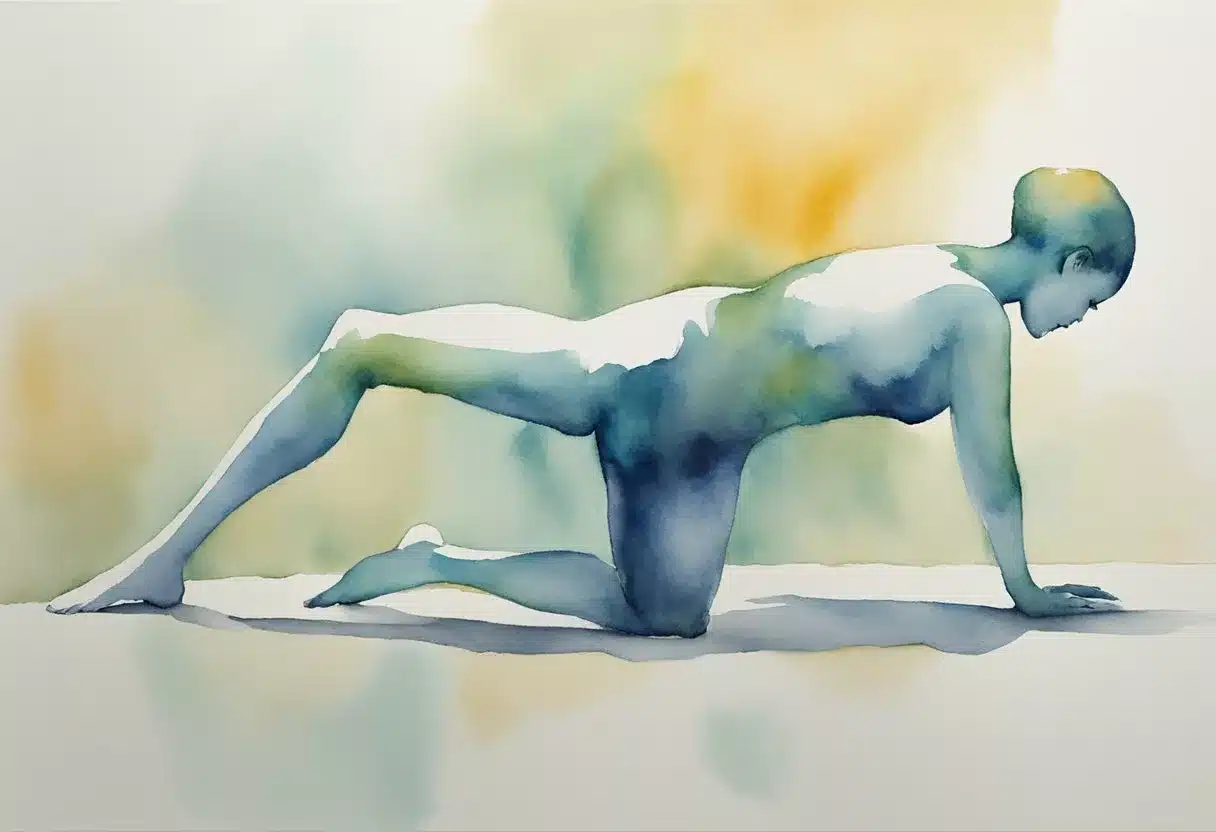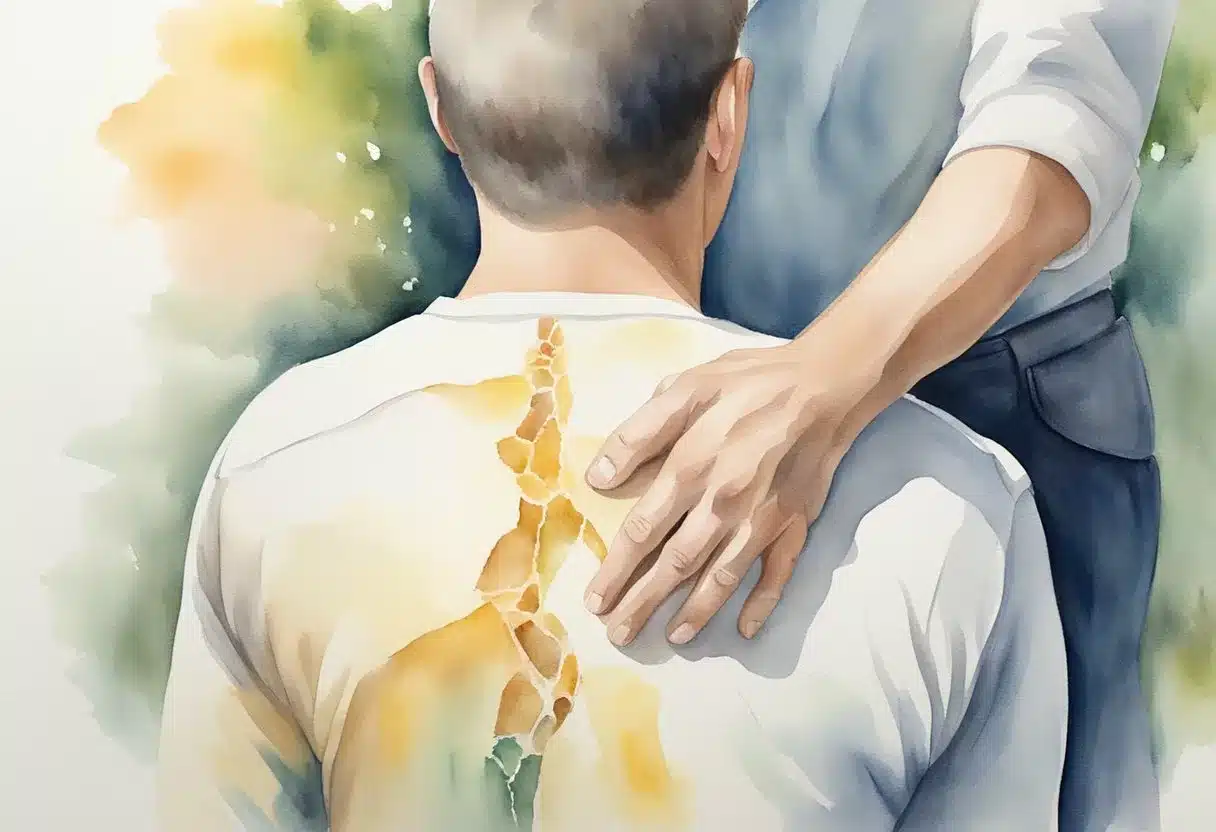Back cracking is a common habit for many people seeking relief from tension or discomfort. The popping sound that occurs when you crack your back can be both satisfying and concerning. When you crack your back, gas bubbles in the synovial fluid between your joints are released, causing the characteristic pop.

This action can provide temporary relief and improved flexibility for some individuals. But is it safe to crack your back regularly? While occasional back cracking is generally harmless, doing it too often or incorrectly may lead to problems.
It’s important to understand the proper techniques and potential risks associated with back cracking. Some people may benefit from professional help, such as seeing a chiropractor, to address underlying issues causing discomfort in their back.
Key Takeaways
- Back cracking releases gas bubbles in joint fluid, causing a popping sound
- Occasional back cracking is usually safe but may pose risks if done excessively
- Proper techniques and professional guidance can help prevent potential harm
Understanding Back Cracking

Back cracking involves specific movements that create a popping sound in the spine. This happens due to changes in joint fluid and pressure within the back.
Anatomy of the Back
The spine consists of 33 vertebrae stacked on top of each other. Between each vertebra are facet joints that allow movement. These joints contain synovial fluid, which acts as a lubricant. The back also has muscles, ligaments, and tendons that support the spine and enable motion.
Nerves run through the spinal column, sending signals between the brain and body. The complex structure of the back allows for flexibility while protecting vital nerves.
What Causes the Cracking Sound?
The cracking sound comes from gas bubbles in the synovial fluid between joints. When someone cracks their back, they stretch the joint capsules. This creates negative pressure, causing dissolved gases to form bubbles.
These bubbles then rapidly collapse, creating the popping noise. The main gases involved are nitrogen, oxygen, and carbon dioxide. The process is similar to opening a soda can.
Back cracking can also happen when tight muscles or ligaments snap over bony areas of the spine. This produces a similar sound but has a different cause than gas bubble formation.
Benefits and Relief

Cracking your back can provide several benefits and relief for many people. When done safely, it may help alleviate discomfort and improve mobility.
Temporary Relief of Discomfort
Back cracking can offer quick relief from back pain and discomfort. The release of gas in the facet joints during cracking may help reduce tension in surrounding muscles. This can ease stiffness and soreness.
Cracking can also help release endorphins, the body’s natural pain relievers. These chemicals can provide a temporary feeling of well-being and reduced pain.
Some people find that cracking helps relieve pressure that builds up between spinal joints. This pressure release may reduce nerve irritation and muscle spasms.
Increase in Range of Motion
Cracking your back may improve flexibility and range of motion. When joints are less stiff, it’s easier to move and stretch.
This increased mobility can be helpful for:
- Daily activities
- Exercise
- Posture improvement
Looser joints and muscles allow for smoother movements. This can reduce the risk of strains or injuries during physical activities.
Psychological Effects of Cracking
Many people experience a sense of satisfaction from cracking their back. This feeling can have positive mental effects.
The act of cracking may:
- Reduce stress
- Promote relaxation
- Provide a sense of relief
For some, the sound and sensation of back cracking triggers a pleasant response. This can lead to improved mood and decreased tension.
The psychological benefits often combine with physical relief. This creates an overall feeling of well-being for many who crack their backs.
Proper Techniques

Cracking your back can be done safely with the right methods. Gentle stretches and specific positions can help release tension and promote spinal health.
Safe Stretching Methods
Gentle stretches are a good way to crack your back safely. Yoga poses can be helpful for this purpose. One easy stretch is the knee-to-chest position.
Lie on your back and pull one knee toward your chest. Hold for 30 seconds, then switch legs. This stretch targets the lower back.
Another safe method is the seated lower back rotation. Sit in a chair with feet flat on the floor. Twist your upper body to one side, holding the back of the chair for support. Hold for 10-15 seconds, then repeat on the other side.
Recommended Positions for Cracking
Proper posture is key when trying to crack your back. The bridge stretch is an effective position. Lie on your back with knees bent and feet flat on the floor. Lift your hips up, creating an arch in your lower back.
For the upper back, try the standing back arch. Stand with feet shoulder-width apart. Place your hands on your lower back for support. Gently arch backward, looking up at the ceiling.
Remember to move slowly and stop if you feel pain. These positions should create a gentle stretch, not force your spine into uncomfortable angles.
Risks and Considerations

Cracking your back can offer relief, but it’s not without risks. It’s important to be aware of potential dangers and know when to seek professional help.
Potential for Injury
Cracking your back incorrectly can lead to muscle strain or joint instability. The spine is a complex structure, and forceful movements may cause harm. People with weak bones or existing back problems face higher risks.
Improper techniques can irritate nerves or damage blood vessels. In rare cases, this might lead to serious complications.
It’s crucial to be gentle when adjusting your back. Avoid twisting too far or applying too much pressure.
When to See a Professional
If back pain persists or worsens after cracking, it’s time to consult a healthcare provider. A doctor, chiropractor, or physical therapist can offer safe, effective treatments.
Seek medical attention for:
- Sudden, severe pain
- Numbness or tingling
- Weakness in legs or arms
- Pain that doesn’t improve with rest
These symptoms may indicate a more serious condition requiring professional care.
Regular check-ups can help prevent long-term issues. A healthcare provider can assess overall spine health and recommend appropriate exercises.
Negative Consequences of Improper Technique
Using incorrect methods to crack your back can lead to various problems. Overstretching ligaments may cause joint instability over time.
Frequent, forceful cracking might irritate soft tissues around the spine. This can result in inflammation and increased pain.
In some cases, improper techniques can worsen existing conditions like herniated discs or spinal stenosis.
To minimize risks:
- Avoid sudden, jerky movements
- Don’t rely on back cracking for pain relief
- Learn proper stretching exercises from a professional
It’s better to address the root cause of back discomfort rather than repeatedly cracking for temporary relief.
Professional Assistance

When back cracking becomes a concern, seeking expert help is crucial. Professionals offer various methods to address spinal issues and improve overall back health.
Chiropractic Care
Chiropractors specialize in spinal adjustments and manipulations. They use hands-on techniques to align the spine and relieve pressure on joints. These methods can help reduce pain and improve mobility.
Chiropractic sessions often involve:
- Spinal assessments
- Manual adjustments
- Soft tissue therapy
Patients may hear popping sounds during treatment. This is normal and typically not harmful. Chiropractors may also provide advice on posture and lifestyle changes to support back health.
Physical Therapy Options
Physical therapists create personalized treatment plans to address back issues. They focus on strengthening muscles and improving flexibility.
Common physical therapy approaches include:
- Targeted exercises
- Stretching routines
- Manual therapy techniques
Therapists may use heat, ice, or electrical stimulation to complement exercises. They teach patients proper body mechanics to prevent future problems. Physical therapy aims to reduce pain and improve function without relying on back cracking.
Consulting with an Osteopath
Osteopaths take a holistic approach to back health. They consider how the spine affects the entire body. Osteopathic treatment may include:
- Gentle manipulations
- Soft tissue techniques
- Postural assessments
Osteopaths often use less forceful methods compared to chiropractors. They may focus on the muscles and connective tissues around the spine. This approach can help improve overall body function and reduce the urge to crack one’s back.
Long-Term Health Implications
Cracking your back regularly can have several effects on your body over time. These range from changes in joint health to posture issues and potential serious health risks.
Impact on Joint Health
Frequent back cracking may lead to joint hypermobility. This means joints can move beyond their normal range, potentially causing instability and pain. Over time, this can increase the risk of developing arthritis.
Repeated cracking may also weaken the ligaments that support the spine. This can result in decreased joint stability and increased vulnerability to injury.
The constant stretching of ligaments from cracking may contribute to the development of osteoarthritis in the long run. This condition causes the breakdown of cartilage in joints, leading to pain and stiffness.
Posture and Chronic Pain
Habitual back cracking can affect posture. When people rely on cracking for temporary relief, they may neglect addressing underlying postural issues.
Poor posture can lead to muscle imbalances and strain. This may result in chronic back pain over time.
Excessive cracking can also cause muscle strain. Strained muscles may lead to ongoing discomfort and contribute to poor posture.
Serious Health Risks
While rare, serious complications can occur from aggressive or frequent back cracking. These include:
- Pinched nerves
- Blood vessel injury
- Increased stroke risk in those predisposed
People with certain conditions should avoid back cracking:
- Severe osteoporosis
- Spinal cancer
- High stroke risk
In some cases, a popping sound in the back known as crepitus may indicate underlying joint issues. If accompanied by pain, it’s important to consult a healthcare professional.
Frequently Asked Questions

Back cracking is a common habit that raises many questions. People wonder about its safety, benefits, causes, and techniques. Let’s explore some key concerns about this practice.
Is it harmful to crack your back by twisting?
Cracking your back too hard or too much can injure blood vessels. This can be dangerous because important vessels in your back connect to your brain.
Excessive twisting may stretch ligaments around the spine. This can lead to joint instability and an unstable body.
Can routine back cracking be beneficial or detrimental to health?
Back cracking once per day is generally considered safe. It can provide temporary relief from stiffness and discomfort.
Frequent cracking may cause problems. It can weaken ligaments and lead to joint instability over time.
What causes the frequent cracking sounds in the back when twisting?
The cracking sound comes from gas bubbles in joint fluid. When joints move, these bubbles burst and create a popping noise.
Frequent cracking may indicate underlying issues. It could be a sign of joint instability or muscle weakness.
What is the best way to safely crack your upper back?
Safe techniques for upper back cracking include gentle stretches. The kneeling back extension and knee-to-chest poses can help.
Always move slowly and stop if you feel pain. It’s best to consult a doctor or physical therapist for personalized advice.
Why is there a sensation of needing to crack the back without the ability to do so?
This feeling often stems from muscle tension or joint stiffness. It may indicate a need for more regular stretching or exercise.
Persistent urges to crack your back could signal an underlying problem. Consider seeing a healthcare provider if this sensation is frequent.
What techniques are there to stop the habit of back cracking?
Regular stretching and exercise can reduce the urge to crack your back. Focus on strengthening core muscles to improve spine stability.
Mindfulness techniques may help break the habit. When you feel the urge, try deep breathing or gentle stretches instead.